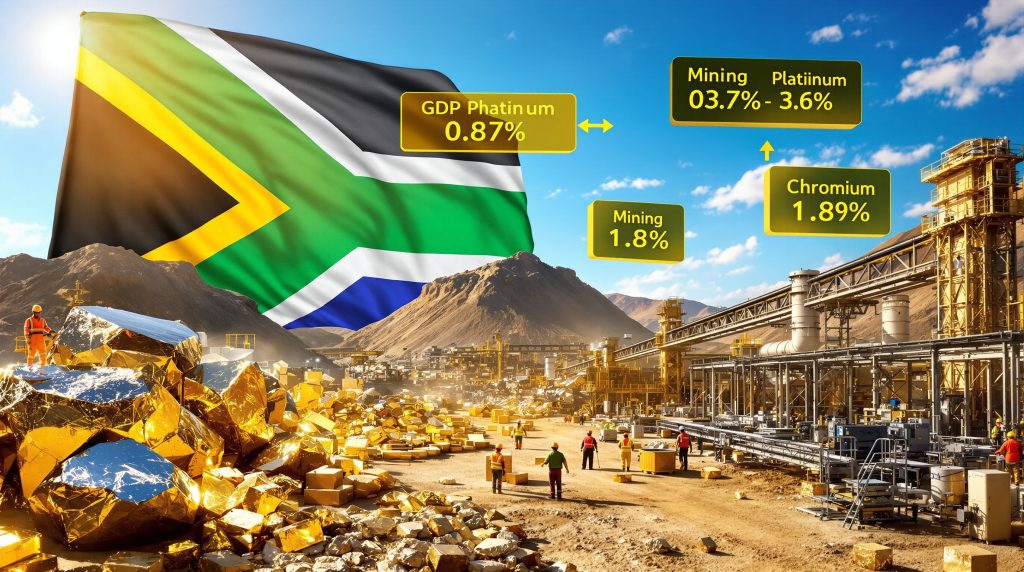South Africa's Economic Resurgence: How Mining and Manufacturing Drive Growth in 2025
South Africa's economy has shown promising signs of recovery in 2025, with a notable 0.8% GDP increase in the second quarter. This growth represents a significant improvement from the modest 0.1% expansion recorded in Q1, offering renewed optimism for the nation's economic trajectory. The mining and manufacturing sectors have emerged as the primary engines of this South Africa mining and manufacturing growth, contributing substantially to the overall economic performance despite persistent structural challenges.
According to Statistics South Africa (Stats SA), this performance marks a modest but important recovery for an economy that has struggled with inconsistent growth patterns in recent years. The improvement comes against a backdrop of ongoing reform efforts aimed at addressing deep-seated structural constraints.
How Has South Africa's Mining Sector Performed in 2025?
Mining's Remarkable Resurgence
The mining sector has demonstrated exceptional resilience, recording a robust 3.7% growth in Q2 2025—its strongest quarterly performance since early 2021. This expansion contributed approximately 0.2 percentage points to the overall GDP growth, highlighting the sector's crucial role in South Africa's economic landscape.
The sector's strong performance reflects both improved global demand for key minerals and the industry's adaptation to domestic operational challenges. Despite persistent electricity supply constraints, mining companies have implemented innovative solutions to maintain production levels.
Key Mineral Production Trends
Several key minerals have driven this impressive performance:
| Mineral | Growth Trend | Contributing Factors |
|---|---|---|
| Platinum Group Metals | Strong positive | Increased global demand, supply chain recovery |
| Gold | Significant uptick | Gold prices record highs exceeding $2,400/oz, investment demand |
| Chromium Ore | Positive | Industrial recovery, stainless steel demand |
| Coal | Moderate growth | Energy demand, export opportunities |
The platinum group metals (PGMs) sector has particularly benefited from automotive industry recovery and growing demand for catalytic converters, while gold production has responded to historically high price levels driven by global economic uncertainty.
Structural Challenges in Mining
Despite the positive performance, the sector continues to navigate several obstacles:
- Escalating electricity costs affecting operational viability
- Logistical bottlenecks hampering export capacity
- Mining permitting challenges in licensing processes
- Skills shortages due to emigration of technical expertise
- Infrastructure constraints limiting production potential
The Minerals Council South Africa notes that while the sector has shown remarkable adaptability, these challenges continue to prevent mining from reaching its full potential contribution to economic growth.
What Is the Current State of South Africa's Manufacturing Sector?
Manufacturing's Contribution to Growth
The manufacturing sector expanded by 1.8% in Q2 2025, contributing 0.2 percentage points to GDP growth. This performance reflects a recovery from earlier challenges and demonstrates the sector's resilience despite persistent headwinds.
Manufacturing's growth has been supported by improved electricity supply reliability compared to previous years, though intermittent load-shedding continues to affect production scheduling and efficiency.
Key Manufacturing Subsectors
The growth was broad-based across several manufacturing divisions:
- Automotive Industry: Production volumes increased by 2.3%, supported by improved global supply chains and domestic assembly operations
- Chemicals, Rubber, and Plastics: Expanded by 2.7%, benefiting from increased industrial activity
- Food and Beverages: Grew by 1.5%, showing resilience in consumer goods production
- Basic Metals and Fabricated Products: Increased by 1.9%, linked to mining sector expansion
The automotive sector's performance is particularly notable as it has benefited from the African Continental Free Trade Area (AfCFTA) implementation, creating expanded regional market access for South African vehicle manufacturers.
Innovation and Adaptation
South African manufacturers have increasingly embraced technological innovation to overcome challenges:
- Implementation of advanced automation systems to enhance productivity
- Adoption of digital technologies to optimize supply chain management
- Energy efficiency initiatives to mitigate electricity supply constraints
- Development of specialized production capabilities to serve niche markets
The Manufacturing Circle, an industry association, reports that companies investing in technological upgrades have shown greater resilience against structural constraints, with digitalization initiatives yielding particular benefits in operational efficiency.
How Are Other Economic Sectors Performing in South Africa?
Trade, Catering, and Accommodation
This sector expanded by 1.7% in Q2 2025, contributing 0.2 percentage points to overall growth. The performance was supported by:
- Increased retail activity as consumer confidence gradually improves
- Recovery in tourism arrivals boosting hospitality revenue
- Growth in informal trade activities across urban centers
Tourism has shown particularly strong recovery, with South African Tourism reporting international visitor numbers approaching pre-pandemic levels, supported by favorable exchange rates for international travelers.
Underperforming Sectors
Several sectors experienced contraction, offsetting some of the gains:
- Transport, Storage, and Communication: Declined by 0.8%, reflecting logistical challenges and infrastructure constraints
- Construction: Contracted by 0.3%, continuing a trend of underinvestment in building projects
- Electricity, Gas, and Water: Experienced minimal growth due to ongoing supply challenges
The continued underperformance of the construction sector is particularly concerning given its potential for job creation and infrastructure development. Industry analysts attribute this to delayed public infrastructure projects and cautious private sector investment.
What Are the Demand-Side Drivers of South Africa's Economic Growth?
Household Consumption Patterns
Household final consumption expenditure showed modest improvement, contributing positively to overall growth:
- Increased spending on semi-durable goods (up 1.3%)
- Stable consumption of non-durable goods (up 0.9%)
- Cautious approach to durable goods purchases (up 0.4%)
Consumer confidence, while still below historical averages, has shown gradual improvement as inflation pressures moderate and employment conditions stabilize in certain sectors.
Trade Balance Improvements
A notable decline in imports coupled with stable export performance strengthened the net export position:
- Imports decreased by 1.2%, reducing the trade deficit
- Exports maintained previous levels despite global economic uncertainties
- Terms of trade improved marginally, supporting overall economic performance
The South African Revenue Service (SARS) data indicates that mining exports have been a key contributor to the positive trade balance, with PGMs and iron ore performing particularly well in export markets.
Investment Challenges
Fixed capital formation remained subdued, highlighting ongoing investment hesitancy:
- Private sector investment grew by only 0.3%
- Public corporation investment declined by 0.7%
- Government infrastructure spending increased by 0.5%, but from a low base
The National Treasury has acknowledged the investment challenge, noting that addressing policy uncertainty and improving the ease of doing business remain key priorities for stimulating capital formation.
What Regional Economic Impact Does South Africa's Growth Have?
SADC Regional Dynamics
South Africa's economic performance has significant implications for the Southern African Development Community:
- As the region's largest economy, South Africa's growth creates positive spillover effects
- Trade linkages with neighboring countries benefit from increased industrial activity
- Investment flows within the region are influenced by South Africa's economic trajectory
According to SADC statistics, South Africa accounts for approximately 60% of the region's combined GDP, making its economic performance a crucial determinant of regional economic health.
Continental Significance
Within the broader African context, South Africa's economic indicators serve as important benchmarks:
- Manufacturing and mining performance offers insights for other resource-rich African economies
- Industrial policy approaches are closely monitored by peer nations
- South Africa's infrastructure development models influence regional integration efforts
The African Development Bank notes that South Africa's implementation of the African Continental Free Trade Agreement has particular significance for industrial development across the continent, with South African manufacturing processes potentially serving as templates for industrial growth elsewhere.
What Are the Structural Reform Priorities for Sustained Growth?
Energy Sector Transformation
Addressing electricity supply constraints remains a critical priority:
- Expansion of independent power production capacity
- Modernization of transmission and distribution infrastructure
- Implementation of energy efficiency programs across industrial sectors
The National Energy Regulator of South Africa (NERSA) has approved several independent power producer licenses in recent quarters, with renewable energy projects beginning to contribute meaningfully to grid stability.
Logistics and Infrastructure Development
Improving transport and logistics capabilities is essential for supporting export-oriented growth:
- Port efficiency enhancement programs
- Rail network rehabilitation initiatives
- Road infrastructure maintenance and expansion
Transnet, the state-owned freight logistics company, has initiated partnership programs with private sector operators to address rail capacity constraints, though implementation remains at an early stage.
Regulatory Environment Improvements
Streamlining bureaucratic processes to facilitate business operations:
- Accelerating mining license approvals
- Reducing compliance burdens for manufacturers
- Enhancing competition in key input markets
Operation Vulindlela, the government's structural reform implementation unit, reports progress in reducing regulatory barriers, though business associations continue to advocate for more rapid reform implementation.
What Is the Economic Outlook for South Africa?
Short-Term Projections
The immediate economic outlook suggests cautious optimism:
- Annual GDP growth for 2025 projected at approximately 1.0%
- Mining sector expected to maintain positive momentum through year-end
- Manufacturing recovery likely to continue but at a moderate pace
The South African Reserve Bank's forecasts align with these projections, though they emphasize that sustainable growth acceleration will require continued reform implementation.
Medium-Term Challenges
Achieving sustainable growth will require addressing fundamental constraints:
- Current growth rates remain below the 3% medium-term target needed for meaningful socioeconomic impact
- Unemployment levels continue to present significant social and economic challenges
- Fiscal constraints limit government's ability to stimulate growth through spending
The National Treasury has emphasized fiscal consolidation as a necessary foundation for sustainable growth, focusing on improving the efficiency of public spending rather than its overall volume.
Opportunity Areas
Several potential catalysts for accelerated growth exist:
- Green economy transitions offering new industrial development opportunities
- Digital economy expansion creating new service sector growth avenues
- Regional integration initiatives expanding market access for South African producers
The Presidential Climate Commission has identified green hydrogen and electric vehicles in mining and component manufacturing as particular growth opportunities aligned with global decarbonization trends.
How Can South Africa Leverage Mining and Manufacturing for Inclusive Growth?
Value Chain Integration
Strengthening linkages between mining and manufacturing offers significant growth potential:
- Mineral beneficiation opportunities to capture greater value domestically
- Development of mining equipment manufacturing capabilities
- Expansion of downstream processing activities
The Department of Trade, Industry and Competition has developed sector-specific plans to enhance local content in mining supply chains, though implementation has faced challenges from established procurement patterns.
Skills Development Imperatives
Addressing human capital needs is crucial for sectoral competitiveness:
- Technical training programs aligned with industry requirements
- Retention strategies for specialized engineering and technical skills
- Knowledge transfer initiatives to develop local expertise
The Mining Qualifications Authority reports increased enrollment in mining-related technical qualifications, though skills mismatches between education outputs and industry needs persist.
Innovation Ecosystem Enhancement
Fostering technological advancement and adaptation:
- Research and development support for mining and manufacturing innovations
- Industry-academia collaboration to solve sector-specific challenges
- AI mining efficiency and technology adoption incentives for small and medium enterprises
The Council for Scientific and Industrial Research (CSIR) has established several industry-focused research units aiming to bridge the gap between academic research and commercial application in key industrial sectors.
What Are the Key Takeaways from South Africa's Economic Performance?
South Africa's Q2 2025 economic performance demonstrates resilience amid challenging conditions. The mining and manufacturing sectors have proven their capacity to drive growth, contributing significantly to the 0.8% GDP expansion. However, structural constraints continue to limit the economy's potential, with growth rates remaining below the levels needed for transformative socioeconomic impact.
The path forward requires coordinated action to address energy security, logistics efficiency, and regulatory barriers while fostering innovation and skills development. With targeted reforms and strategic investments, South Africa can build on the current momentum to achieve more inclusive and sustainable South Africa mining and manufacturing growth.
FAQ: South Africa's Economic Growth in 2025
What was South Africa's GDP growth rate in Q2 2025?
South Africa's economy grew by 0.8% in the second quarter of 2025, improving from 0.1% in the first quarter.
Which sectors contributed most to South Africa's economic growth?
Mining, manufacturing, and trade were the primary growth drivers, collectively contributing 0.6 percentage points to the 0.8% GDP increase.
How much did the mining sector grow in Q2 2025?
The mining sector expanded by 3.7%, its strongest quarterly performance since early 2021.
What minerals drove South Africa's mining growth?
Platinum group metals, gold, and chromium ore were the key contributors to mining sector growth.
What are the main challenges facing South Africa's economic growth?
Energy security, logistics inefficiencies, regulatory barriers, and skills shortages remain the principal constraints to sustained economic expansion.
Is South Africa's current growth rate sufficient for its development needs?
No, the current growth rate of approximately 1% annually falls below the 3% medium-term target needed to address unemployment and socioeconomic challenges effectively.
Further Exploration:
Readers interested in learning more about South Africa's economic development can also explore related educational content from African Mining Market, which offers regional economic analysis and insights on African mining sectors.
Ready to Capitalise on the Next Major Mining Discovery?
Discover why historic ASX mining discoveries can generate substantial returns by exploring Discovery Alert's proprietary Discovery IQ model, which instantly alerts investors to significant mineral discoveries, turning complex data into actionable insights. Visit the dedicated discoveries page to begin your 30-day free trial today and position yourself ahead of the market.




